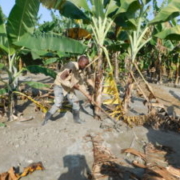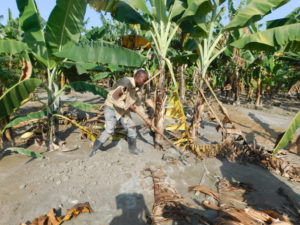Gulu Arch-Diocese roots for commercialization of cassava production in Acholi sub-region
A total of 10,000 commercial cassava farmers in Acoli sub-region are receiving cassava stems from the Operation Wealth Creation program to support commercialization of cassava growing and production in the sub-region.
In March this year, President Museveni launched the project dubbed Acholibur Parish Project (APP) in Acholibur sub county, Pader district and asked farmers to grow cassava as a strategic crop.
The project was initiated by Gulu Arch diocese, and according to the reigning Bishop John Baptist Odama, aims to commercialize cassava growing and increase financial and food security in Acholi Sub region.
In 2017, the pilot project was kicked off in Pader district, with 40,000 bags of cassava stems worth 2 billion shillings given to 6900 households.
Now, Brig. Francis Acoka Ongom, the OWC coordinator for Acholi sub-region told theCooperator that at least 75,000 bags of Narocas-1 cassava cuttings worth shs.3 billion will be distributed to select commercial cassava growers in the districts of Gulu, Amuru, Nwoya, Omoro, Pader, Agago, Kitgum and Lamwo districts by the end of this month, as part of the full implementation of the project in the entirety of Acholi sub-region.
According to Ongom, each of the selected 10,000 farmers will be expected to plant two acres of cassava, totaling to 937.5 acres of cassava.
The project chairperson Fr. Matthew Lagoro Okun says registration of potential beneficiaries is still ongoing.
“In the past cassava stems were just taken to sub counties and dumped there without registering the names of those who wanted them. This led to reports of many bags of stems drying up, leading to loss of millions of shillings. We don’t want that to happen again,” Fr. Okun said.
Why Cassava?
Asked why cassava of all crops, Ongom argued that Cassava was found to be a “strategic” crop, both for its durability, and for its nutrients. “The granary of cassava is underground, so even if the whole garden is set afire, the tubers cannot be affected. It is also a whole meal. Even if you boil it without salt and eat it without sauce, you will get full,” he said.
He also added that Cassava starch was highly sought-after in the paper and textile industries because of its binding properties, and that mass production of the crop could help reduce cost of importation of products made using cassava, such as ethanol, which is used during surgeries in hospitals.
“Uganda annually imports ethanol-based spirits from Thailand worth 500 million US dollars. So, if we are producing cassava from here, we can start producing ethanol from here and reduce such import costs,” he said.
“No part of a cassava plant is waste. The peelings are used as animal feed or manure. The leaves are eaten and the stems are replanted. It is such a wonderful crop. It is a silver bullet for financial and food insecurity in the region,” he added.
Insufficient Market?
Although the crop has been welcomed as an alternative to Cotton and Tobacco – the traditional cash crops grown in the area, farmers remain worried about the readiness of the crop’s market. Last year, the 6900 farmers who piloted the APP project in Pader district claimed that they struggled to find market for their harvest.
Ongom says the market issue is not something they didn’t anticipate. “We have already partnered with Bukona Agro Processors Limited in Nwoya district, to buy the cassava from the farmers when harvested,” he told theCooperator, adding “The processing plant uses cassava worth 15 acres daily in their industries, which is about 200 metric tonnes. If they increase their capacity, all these acres of cassava being planted in Acholi sub-region won’t even be enough for their industry.”
Currently, Bukona Agro Processors Limited is producing hand sanitizers out of cassava, which are being used in Gulu and the neighboring districts as one of the measures against COVID-19.
Apart from Bukona, Ongom says that tons of cassava are also bought by middle men and taken to Soroti, Kotido and Lango sub-region, all the way to Kampala.
As a way of ensuring reasonable farm-gate prices, Ongom says they’re discouraging farmers from selling to middlemen individually, and to instead form cooperatives. “Cooperatives will help them(farmers) to store together and market as a group, where they will have strong bargaining power,” he said.
The post Gulu Arch-Diocese roots for commercialization of cassava production in Acholi sub-region appeared first on The Cooperator News.


